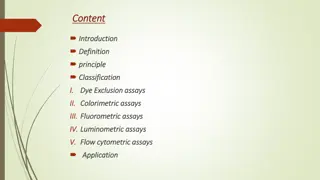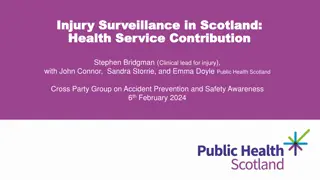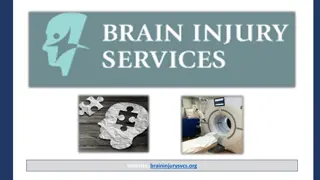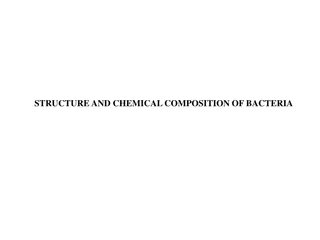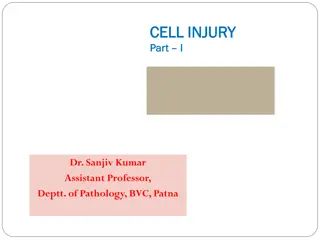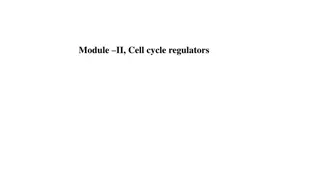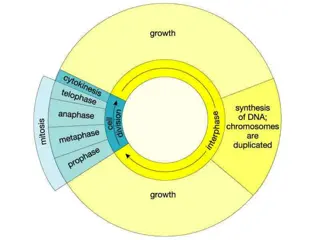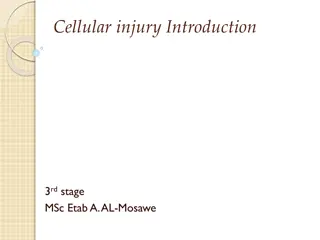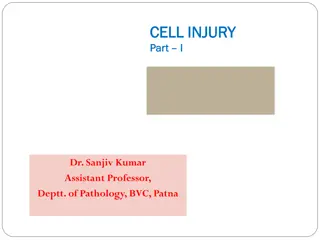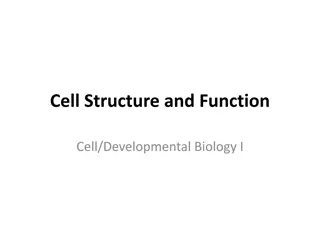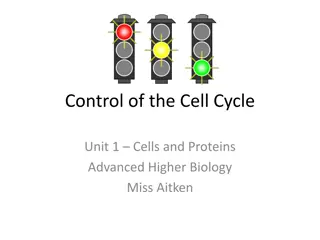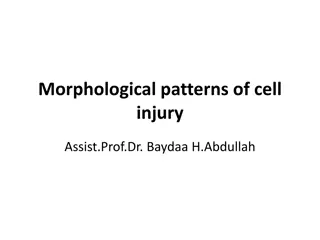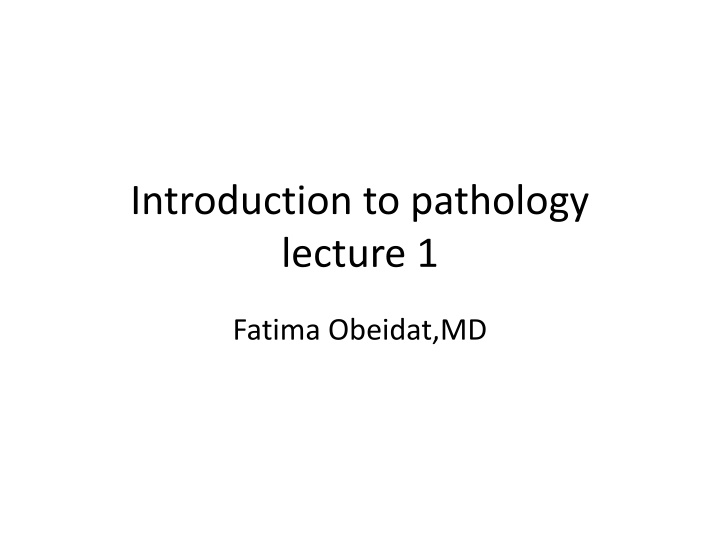
Mechanisms of Cell Injury and Adaptation in Pathology
Explore the principles of cell injury and adaptation in pathology, focusing on the depletion of ATP, maintenance of homeostasis, response to stress, reversible and irreversible cell injury, and adaptive changes in cells. Learn how cells maintain function in response to environmental changes and the consequences of severe stress on cell viability.
Download Presentation

Please find below an Image/Link to download the presentation.
The content on the website is provided AS IS for your information and personal use only. It may not be sold, licensed, or shared on other websites without obtaining consent from the author. If you encounter any issues during the download, it is possible that the publisher has removed the file from their server.
You are allowed to download the files provided on this website for personal or commercial use, subject to the condition that they are used lawfully. All files are the property of their respective owners.
The content on the website is provided AS IS for your information and personal use only. It may not be sold, licensed, or shared on other websites without obtaining consent from the author.
E N D
Presentation Transcript
Introduction to pathology lecture 1 Fatima Obeidat,MD
Depletion of ATP Consequences
Cells normally maintain a steady state called Homeostasis. This means the intracellular environment is kept within a narrow range of physiologic state Examples: temperature, pH, chemical reactions, electrolyte concentration, water content All are regulated and kept constant.
Cells and stress! If cells are subjected to stresses ( like changes in electrolyte balance) then cells adapt and reach a new homeostatic state that will preserve cell function. However if the stress is more severe and is beyond capability of adaptation then this will result in cell injury.
Cell injury: at the beginning it is reversible within certain limits Then it becomes irreversible. Irreversible injury ends in cell death. Two types of cell death: necrosis and apoptosis ( more details later)
Note Not all injuries start as reversible then become irreversible If the injury is severe enough it will be irreversible even in the early stages.
Adaptation in cells Adaptation means: reversible changes in the a. number b. size c. phenotype, d. metabolic activity or e. function of cells in response to changes in their environment.
Adaptation Adaptive changes are reversible.: if the insult is removed, things can go back to normal. Can be physiologic or pathologic; depending on the cause
Cells and tissues adapt by four main mechanisms Hyertrophy Hyperplasia Atrophy Metaplasia
Hypertrophy: Increased cell size. Hyperplasia: increased number of cells occurs in labile cells, the cells that undergo.. Cell division. Metaplasia: change from one adult cell type to another Atrophy: decreased size.
Hypertrophy Increased cell size. Due to increased organelles and proteins. Increased intracellular synthesis of the proteins and organelles. Caused by: increased demands, hormones or growth factors.
Examples of Physiologic hypertrophy a. Uterus during pregnancy due to oestrogen effect on smooth muscles of the uterine wall. b. Skeletal muscle in body builders due to increased demand. Note: smooth muscles can divide.. So in the pregnant uterus there is hypertrophy and hyperplasia whereas skeletal muscle is permanent tissue that can not divide, so there is pure hypertrophy without hyperplasia.
Physiologic hypertrophy Uterine wall
Pathologic hypertrophy Cardiac enlargement due to hypertension = Hypertensive heart disease Pathogenesis.. Two types of signals: mechanical: stretch and trophic: growth factors and androgenic hormones cause the hypertrophy in the cardiac muscle Note: the cardiac muscle can not undergo hyperplasia because it is a permanent cell.
Cardiac hypertrophy during hypertension results in more contractile force that is needed to meet the demands of the increased pressure This works to a certain extent.. But with time hypertrophy can not compensate for for the increased burden and degenerate changes occur in the muscle.
The myofibrllar contractile elements will be fragmented Why hypertrophy can not compensate forever??? Maybe because there is limited blood supply and limited mitochondria to provide ATP .. So if there is more tissue than that can be supported by this blood supply and energy then degeneration occurs.
Hyperplasia: increased cell proliferation and division Only in tissues that can replicate. Can be physiologic or pathologic. Occurs due to proliferation of both differentiated cells and stem cells.
Cell division Morphologically: we see mitosis
Physiologic hyperplasia Hormonal: uterus, breast. Compensatory: after removal or loss of part of tissue such as liver in transplantation. - In liver transplantation, after part of the liver is excised , the mitotic activity will start after 12 hours eventually restoring the normal size of the liver
Pathologic hyperplasia Due to excess in hormones or growth factors. E:g endometrial hyperplasia due to oestrogen- progesterone imbalance. Hyperplasia is controlled.. it responds to normal growth stimuli and inhibitors .This differentiates it from cancer because cancer keeps growing regardless of normal growth mechanisms.
Note: However.. Because hyperplastic tissue divides there is more chance that it will acquire mutations that can lead to cancer. -This occurs more in pathologic hyperplasia, because the stimuli are long lived
atrophy Shrinkage in cell size due to loss of cell substance. Causes Decreased work load. Loss of innervation Loss of endocrine stimulation. Decrease blood supply Aging
Atrophy Physiologic: endometrial atrophy during menopause Pathologic: loss of innervation such as in poliomyelitis.
atrophy Mechanisms: Decreased protein synthesis. Degradation of cellular proteins, mainly by ubiquitin- proteasome pathway.. Proteins are attached to ubiquitin which targets them to be degraded by proteasome. Autophagy . Literally means self eating.
metaplasia Adult cell type replaced by another adult cell type. The cell type sensitive to a certain stress changes to another type which can better tolerate this particular stress. Arise due to reprogramming of stem cells to differentiate along a new pathway.
Epithelial metaplasia/ example Respiratory epithelium which is normally glandular, if exposed to smoking it changes to squamous epithelium, which can cope better with the smoke However, this change means loss of the goblet cells that are present in the columnar glandular epithelium.. So no mucus secretion Also there will be loss of the cilia.. So there is loss of important protective in metaplastic tissue.
Barrett mucosa This is another example of metaplasia Normal esophageal mucosa is stratified squamous If there is reflux of gastric content into the stomach, the esophageal epithelium changes to glandular.. So it can withstand the acidity.
Metaplasia in mesenchymal tissue Usually pathologic Ossification of soft tissue due to injury.
Vitamin A and metaplasia Vitamin A is important for epithelial differentiation If there is Vitamin A deficiency metaplasia can happen.. Especially in the respiratory epithelium.
Metaplasia and cancer The stimuli that cause metaplasia if persist for a long time can cause cancer So metaplasia is considered premalignant.


